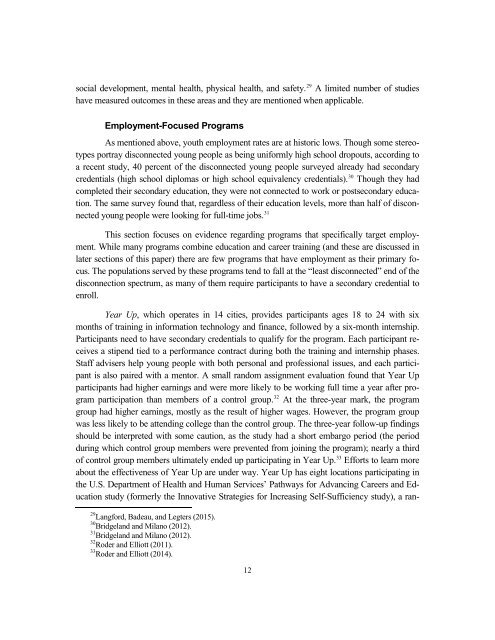Opportunity Youth: Disenfranchised Young People
Opportunity Youth: Disenfranchised Young People
Opportunity Youth: Disenfranchised Young People
You also want an ePaper? Increase the reach of your titles
YUMPU automatically turns print PDFs into web optimized ePapers that Google loves.
social development, mental health, physical health, and safety. 29 A limited number of studies<br />
have measured outcomes in these areas and they are mentioned when applicable.<br />
Employment-Focused Programs<br />
As mentioned above, youth employment rates are at historic lows. Though some stereotypes<br />
portray disconnected young people as being uniformly high school dropouts, according to<br />
a recent study, 40 percent of the disconnected young people surveyed already had secondary<br />
credentials (high school diplomas or high school equivalency credentials). 30 Though they had<br />
completed their secondary education, they were not connected to work or postsecondary education.<br />
The same survey found that, regardless of their education levels, more than half of disconnected<br />
young people were looking for full-time jobs. 31<br />
This section focuses on evidence regarding programs that specifically target employment.<br />
While many programs combine education and career training (and these are discussed in<br />
later sections of this paper) there are few programs that have employment as their primary focus.<br />
The populations served by these programs tend to fall at the “least disconnected” end of the<br />
disconnection spectrum, as many of them require participants to have a secondary credential to<br />
enroll.<br />
Year Up, which operates in 14 cities, provides participants ages 18 to 24 with six<br />
months of training in information technology and finance, followed by a six-month internship.<br />
Participants need to have secondary credentials to qualify for the program. Each participant receives<br />
a stipend tied to a performance contract during both the training and internship phases.<br />
Staff advisers help young people with both personal and professional issues, and each participant<br />
is also paired with a mentor. A small random assignment evaluation found that Year Up<br />
participants had higher earnings and were more likely to be working full time a year after program<br />
participation than members of a control group. 32 At the three-year mark, the program<br />
group had higher earnings, mostly as the result of higher wages. However, the program group<br />
was less likely to be attending college than the control group. The three-year follow-up findings<br />
should be interpreted with some caution, as the study had a short embargo period (the period<br />
during which control group members were prevented from joining the program); nearly a third<br />
of control group members ultimately ended up participating in Year Up. 33 Efforts to learn more<br />
about the effectiveness of Year Up are under way. Year Up has eight locations participating in<br />
the U.S. Department of Health and Human Services’ Pathways for Advancing Careers and Education<br />
study (formerly the Innovative Strategies for Increasing Self-Sufficiency study), a ran-<br />
29 Langford, Badeau, and Legters (2015).<br />
30 Bridgeland and Milano (2012).<br />
31 Bridgeland and Milano (2012).<br />
32 Roder and Elliott (2011).<br />
33 Roder and Elliott (2014).<br />
12

















